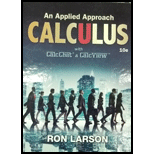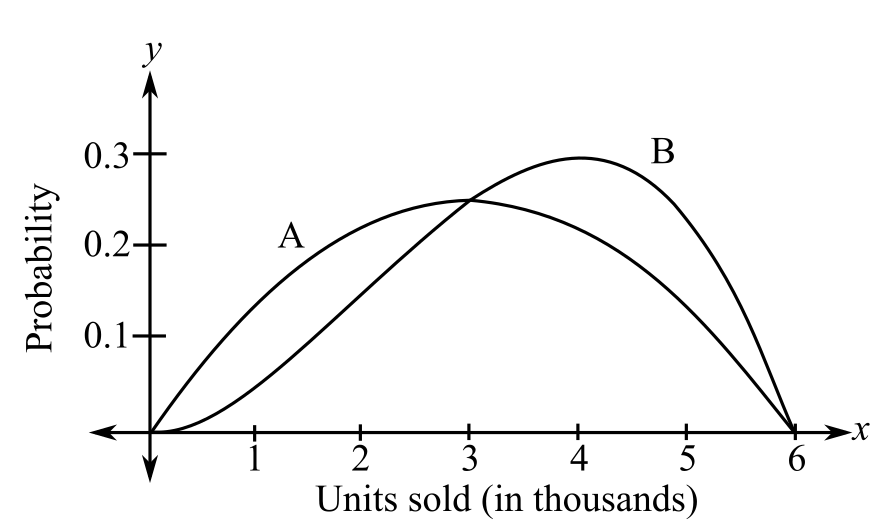
Calculus: An Applied Approach (MindTap Course List)
10th Edition
ISBN: 9781305860919
Author: Ron Larson
Publisher: Cengage Learning
expand_more
expand_more
format_list_bulleted
Concept explainers
Question
Chapter 9.2, Problem 32E
(a)
To determine
Whether the probability of selling, which of the model is higher between the interval

(b)
To determine
Whether the probability of selling, which of the model is higher between the interval

Expert Solution & Answer
Want to see the full answer?
Check out a sample textbook solution
Students have asked these similar questions
Explain the key points of 11.5.2
Explain the key points of 11.3.5
Practice using 11.5.2 to derive 11.6.1
Chapter 9 Solutions
Calculus: An Applied Approach (MindTap Course List)
Ch. 9.1 - Checkpoint 1 Worked-out solution available at...Ch. 9.1 - Prob. 2CPCh. 9.1 - Prob. 3CPCh. 9.1 - Prob. 4CPCh. 9.1 - Prob. 5CPCh. 9.1 - Prob. 6CPCh. 9.1 - Prob. 1SWUCh. 9.1 - Prob. 2SWUCh. 9.1 - Prob. 3SWUCh. 9.1 - Prob. 4SWU
Ch. 9.1 - Prob. 5SWUCh. 9.1 - Prob. 6SWUCh. 9.1 - Prob. 7SWUCh. 9.1 - Prob. 8SWUCh. 9.1 - Prob. 9SWUCh. 9.1 - Prob. 10SWUCh. 9.1 - Prob. 1ECh. 9.1 - Prob. 2ECh. 9.1 - Prob. 3ECh. 9.1 - Prob. 4ECh. 9.1 - Prob. 5ECh. 9.1 - Prob. 6ECh. 9.1 - Prob. 7ECh. 9.1 - Random Selection A card is chosen at random from a...Ch. 9.1 - Prob. 9ECh. 9.1 - Prob. 10ECh. 9.1 - Identifying Probability Distributions In Exercises...Ch. 9.1 - Prob. 12ECh. 9.1 - Prob. 13ECh. 9.1 - Prob. 14ECh. 9.1 - Prob. 15ECh. 9.1 - Using Probability Distributions In Exercises 1518,...Ch. 9.1 - Prob. 17ECh. 9.1 - Prob. 18ECh. 9.1 - Prob. 19ECh. 9.1 - Children The table shows the probability...Ch. 9.1 - Prob. 21ECh. 9.1 - Die Roll Consider the experiment of rolling a...Ch. 9.1 - Prob. 23ECh. 9.1 - Prob. 24ECh. 9.1 - Prob. 25ECh. 9.1 - Prob. 26ECh. 9.1 - Prob. 27ECh. 9.1 - Prob. 28ECh. 9.1 - Prob. 29ECh. 9.1 - Personal Income The probability distribution of...Ch. 9.1 - Insurance An insurance company needs to determine...Ch. 9.1 - Insurance An insurance company needs to determine...Ch. 9.1 - Baseball A baseball fan examined the record of a...Ch. 9.1 - Games of Chance If x is a players net gain in a...Ch. 9.1 - Games of Chance If x is a players net gain in a...Ch. 9.1 - Prob. 37ECh. 9.1 - Prob. 38ECh. 9.2 - Prob. 1CPCh. 9.2 - Prob. 2CPCh. 9.2 - Prob. 3CPCh. 9.2 - Prob. 4CPCh. 9.2 - Prob. 5CPCh. 9.2 - Prob. 1SWUCh. 9.2 - Prob. 2SWUCh. 9.2 - Prob. 3SWUCh. 9.2 - Prob. 4SWUCh. 9.2 - Prob. 5SWUCh. 9.2 - Prob. 6SWUCh. 9.2 - Prob. 7SWUCh. 9.2 - Prob. 1ECh. 9.2 - Prob. 2ECh. 9.2 - Prob. 3ECh. 9.2 - Prob. 4ECh. 9.2 - Prob. 5ECh. 9.2 - Prob. 6ECh. 9.2 - Prob. 7ECh. 9.2 - Prob. 8ECh. 9.2 - Prob. 9ECh. 9.2 - Prob. 10ECh. 9.2 - Prob. 11ECh. 9.2 - Prob. 12ECh. 9.2 - Prob. 13ECh. 9.2 - Prob. 14ECh. 9.2 - Prob. 15ECh. 9.2 - Making a Probability Density Function In Exercises...Ch. 9.2 - Prob. 17ECh. 9.2 - Prob. 18ECh. 9.2 - Prob. 19ECh. 9.2 - Finding a Probability In Exercises 19-26, sketch...Ch. 9.2 - Prob. 21ECh. 9.2 - Prob. 22ECh. 9.2 - Prob. 23ECh. 9.2 - Prob. 24ECh. 9.2 - Prob. 25ECh. 9.2 - Finding a Probability In Exercises 19-26, sketch...Ch. 9.2 - Prob. 27ECh. 9.2 - Prob. 28ECh. 9.2 - Prob. 29ECh. 9.2 - Demand The daily demand for gasoline x (in...Ch. 9.2 - Prob. 31ECh. 9.2 - Prob. 32ECh. 9.2 - Using the Exponential Density Function In...Ch. 9.2 - Prob. 34ECh. 9.2 - Using the Exponential Density Function In...Ch. 9.2 - Prob. 36ECh. 9.2 - Prob. 37ECh. 9.2 - Demand The weekly demand x (in tons) for a certain...Ch. 9.2 - Prob. 39ECh. 9.3 - Prob. 1CPCh. 9.3 - Find the variance and standard deviation of the...Ch. 9.3 - Use a symbolic integration utility to find the...Ch. 9.3 - Prob. 4CPCh. 9.3 - Prob. 5CPCh. 9.3 - Prob. 6CPCh. 9.3 - Prob. 7CPCh. 9.3 - Prob. 1SWUCh. 9.3 - Prob. 2SWUCh. 9.3 - Prob. 3SWUCh. 9.3 - Prob. 4SWUCh. 9.3 - Prob. 5SWUCh. 9.3 - Prob. 6SWUCh. 9.3 - Finding Expected Value, Variance, and Standard...Ch. 9.3 - Prob. 2ECh. 9.3 - Prob. 3ECh. 9.3 - Prob. 4ECh. 9.3 - Finding Expected Value, Variance, and Standard...Ch. 9.3 - Prob. 6ECh. 9.3 - Prob. 7ECh. 9.3 - Prob. 8ECh. 9.3 - Prob. 9ECh. 9.3 - Prob. 10ECh. 9.3 - Prob. 11ECh. 9.3 - Finding Expected Value, Variance, and Standard...Ch. 9.3 - Prob. 13ECh. 9.3 - Using Two Methods In Exercises 13-16, find the...Ch. 9.3 - Prob. 15ECh. 9.3 - Using two Methods In Exercises 1316, find the...Ch. 9.3 - Using Technology In Exercises 17-22, use a...Ch. 9.3 - Using Technology In Exercises 17-22, use a...Ch. 9.3 - Using Technology In Exercises 17-22, use a...Ch. 9.3 - Using Technology In Exercises 17-22, use a...Ch. 9.3 - Prob. 21ECh. 9.3 - Prob. 22ECh. 9.3 - Prob. 23ECh. 9.3 - Prob. 24ECh. 9.3 - Prob. 25ECh. 9.3 - Prob. 26ECh. 9.3 - Prob. 27ECh. 9.3 - Prob. 28ECh. 9.3 - Prob. 29ECh. 9.3 - Prob. 30ECh. 9.3 - Prob. 31ECh. 9.3 - Prob. 32ECh. 9.3 - Prob. 33ECh. 9.3 - Prob. 34ECh. 9.3 - Prob. 35ECh. 9.3 - Prob. 36ECh. 9.3 - Consumer Trends The number of coupons x used by a...Ch. 9.3 - Prob. 38ECh. 9.3 - Prob. 39ECh. 9.3 - Prob. 40ECh. 9.3 - Transportation The arrival time t (in minutes) of...Ch. 9.3 - Prob. 42ECh. 9.3 - Prob. 43ECh. 9.3 - Prob. 44ECh. 9.3 - Prob. 45ECh. 9.3 - License Renewal The waiting time t (in minutes) at...Ch. 9.3 - Demand The daily demand x for a certain product...Ch. 9.3 - Prob. 48ECh. 9.3 - Demand The daily demand x for water (in millions...Ch. 9.3 - Prob. 50ECh. 9.3 - Prob. 54ECh. 9.3 - Prob. 55ECh. 9.3 - Education For high school graduates from 2012...Ch. 9.3 - Prob. 57ECh. 9 - Prob. 1RECh. 9 - Prob. 2RECh. 9 - Prob. 3RECh. 9 - Prob. 4RECh. 9 - Prob. 5RECh. 9 - Prob. 6RECh. 9 - Prob. 7RECh. 9 - Prob. 8RECh. 9 - Prob. 9RECh. 9 - Prob. 10RECh. 9 - Prob. 11RECh. 9 - Prob. 12RECh. 9 - Prob. 13RECh. 9 - Prob. 14RECh. 9 - Prob. 15RECh. 9 - Prob. 16RECh. 9 - Revenue A publishing company introduces a new...Ch. 9 - Prob. 18RECh. 9 - Prob. 19RECh. 9 - Prob. 20RECh. 9 - Prob. 21RECh. 9 - Prob. 22RECh. 9 - Prob. 23RECh. 9 - Prob. 24RECh. 9 - Prob. 25RECh. 9 - Prob. 26RECh. 9 - Prob. 27RECh. 9 - Prob. 28RECh. 9 - Prob. 29RECh. 9 - Prob. 30RECh. 9 - Prob. 31RECh. 9 - Prob. 32RECh. 9 - Prob. 33RECh. 9 - Prob. 34RECh. 9 - Prob. 35RECh. 9 - Prob. 36RECh. 9 - Waiting Time The waiting time t (in minutes) for...Ch. 9 - Prob. 38RECh. 9 - Prob. 39RECh. 9 - Prob. 40RECh. 9 - Prob. 41RECh. 9 - Prob. 42RECh. 9 - Prob. 43RECh. 9 - Prob. 44RECh. 9 - Prob. 45RECh. 9 - Prob. 46RECh. 9 - Prob. 47RECh. 9 - Prob. 48RECh. 9 - Prob. 49RECh. 9 - Prob. 50RECh. 9 - Prob. 51RECh. 9 - Prob. 52RECh. 9 - Prob. 53RECh. 9 - Prob. 54RECh. 9 - Prob. 55RECh. 9 - Prob. 56RECh. 9 - Prob. 57RECh. 9 - Prob. 58RECh. 9 - Prob. 59RECh. 9 - Prob. 60RECh. 9 - Prob. 61RECh. 9 - Prob. 62RECh. 9 - Prob. 1TYSCh. 9 - Prob. 2TYSCh. 9 - Prob. 3TYSCh. 9 - Prob. 4TYSCh. 9 - Prob. 5TYSCh. 9 - Prob. 6TYSCh. 9 - Prob. 7TYSCh. 9 - Prob. 8TYSCh. 9 - Prob. 9TYSCh. 9 - Prob. 10TYSCh. 9 - Prob. 11TYSCh. 9 - Prob. 12TYSCh. 9 - Prob. 13TYSCh. 9 - Prob. 14TYSCh. 9 - Prob. 15TYSCh. 9 - Prob. 16TYS
Knowledge Booster
Learn more about
Need a deep-dive on the concept behind this application? Look no further. Learn more about this topic, calculus and related others by exploring similar questions and additional content below.Similar questions
arrow_back_ios
SEE MORE QUESTIONS
arrow_forward_ios
Recommended textbooks for you

 Big Ideas Math A Bridge To Success Algebra 1: Stu...AlgebraISBN:9781680331141Author:HOUGHTON MIFFLIN HARCOURTPublisher:Houghton Mifflin Harcourt
Big Ideas Math A Bridge To Success Algebra 1: Stu...AlgebraISBN:9781680331141Author:HOUGHTON MIFFLIN HARCOURTPublisher:Houghton Mifflin Harcourt Glencoe Algebra 1, Student Edition, 9780079039897...AlgebraISBN:9780079039897Author:CarterPublisher:McGraw Hill
Glencoe Algebra 1, Student Edition, 9780079039897...AlgebraISBN:9780079039897Author:CarterPublisher:McGraw Hill Algebra and Trigonometry (MindTap Course List)AlgebraISBN:9781305071742Author:James Stewart, Lothar Redlin, Saleem WatsonPublisher:Cengage Learning
Algebra and Trigonometry (MindTap Course List)AlgebraISBN:9781305071742Author:James Stewart, Lothar Redlin, Saleem WatsonPublisher:Cengage Learning Holt Mcdougal Larson Pre-algebra: Student Edition...AlgebraISBN:9780547587776Author:HOLT MCDOUGALPublisher:HOLT MCDOUGAL
Holt Mcdougal Larson Pre-algebra: Student Edition...AlgebraISBN:9780547587776Author:HOLT MCDOUGALPublisher:HOLT MCDOUGAL


Big Ideas Math A Bridge To Success Algebra 1: Stu...
Algebra
ISBN:9781680331141
Author:HOUGHTON MIFFLIN HARCOURT
Publisher:Houghton Mifflin Harcourt

Glencoe Algebra 1, Student Edition, 9780079039897...
Algebra
ISBN:9780079039897
Author:Carter
Publisher:McGraw Hill

Algebra and Trigonometry (MindTap Course List)
Algebra
ISBN:9781305071742
Author:James Stewart, Lothar Redlin, Saleem Watson
Publisher:Cengage Learning

Holt Mcdougal Larson Pre-algebra: Student Edition...
Algebra
ISBN:9780547587776
Author:HOLT MCDOUGAL
Publisher:HOLT MCDOUGAL

Use of ALGEBRA in REAL LIFE; Author: Fast and Easy Maths !;https://www.youtube.com/watch?v=9_PbWFpvkDc;License: Standard YouTube License, CC-BY
Compound Interest Formula Explained, Investment, Monthly & Continuously, Word Problems, Algebra; Author: The Organic Chemistry Tutor;https://www.youtube.com/watch?v=P182Abv3fOk;License: Standard YouTube License, CC-BY
Applications of Algebra (Digit, Age, Work, Clock, Mixture and Rate Problems); Author: EngineerProf PH;https://www.youtube.com/watch?v=Y8aJ_wYCS2g;License: Standard YouTube License, CC-BY